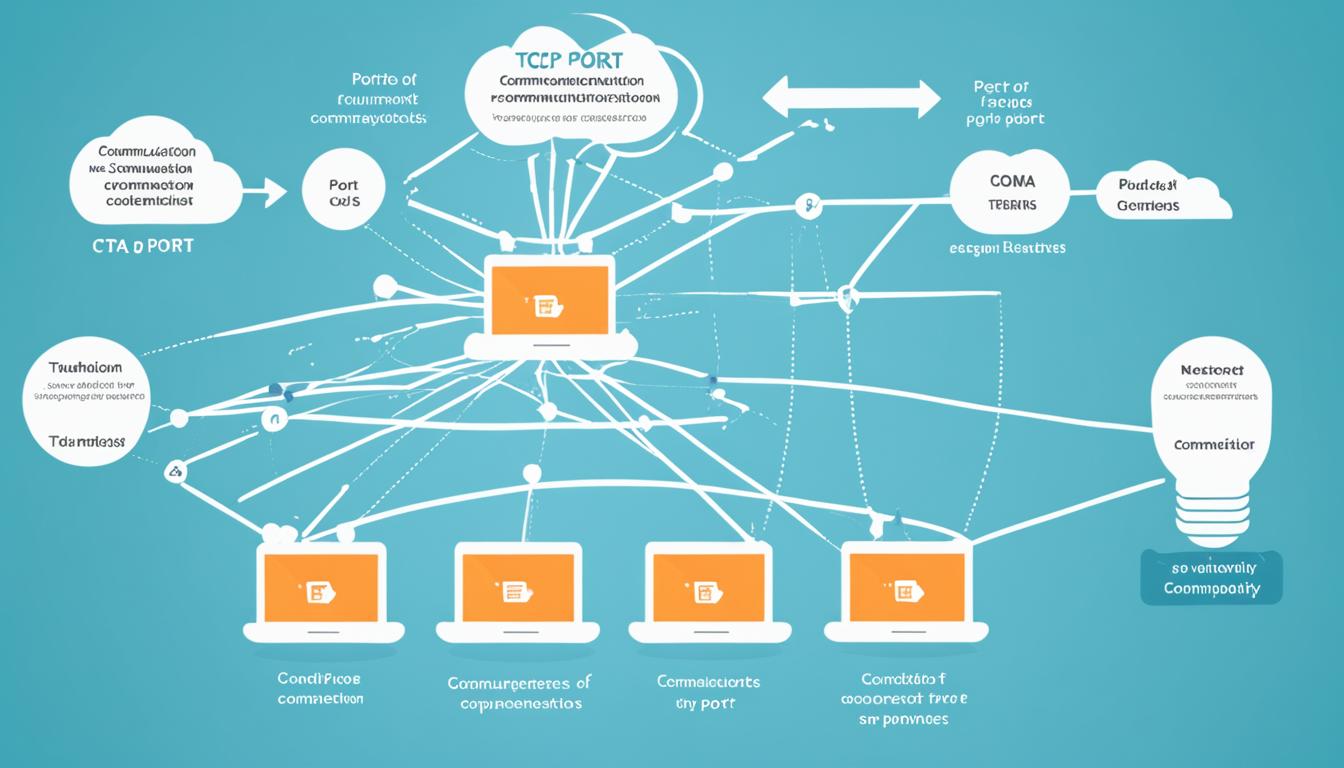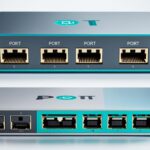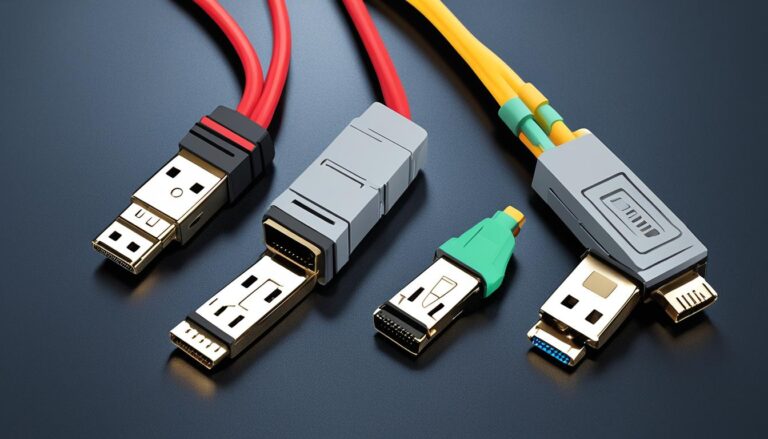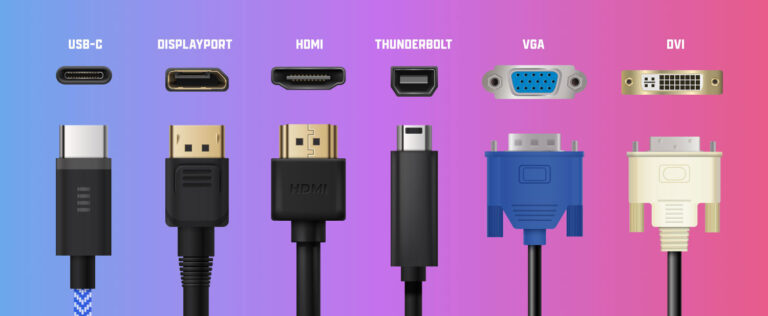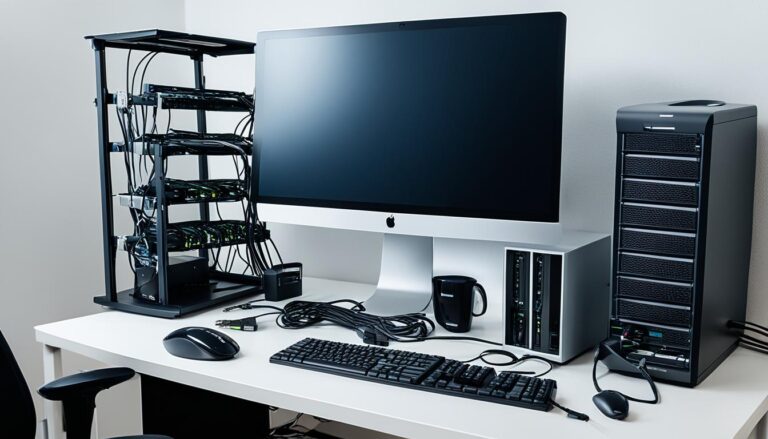TCP Port 3, known as compressnet, is crucial for network communications. It boosts data transmission efficiency and security. This makes it important for network administrators and cybersecurity experts. Various applications use TCP Port 3. These include Delta Force, Midnight Commander, and the SynDrop trojan.
It’s vital to know the role of TCP Port 3 in network communications. This knowledge helps organizations improve their data transmission and security. By managing TCP Ports well, network administrators can make data transmission better and safer.
What Are TCP Ports?
TCP Ports are like labels in TCP segments. They help separate different services on one IP address. These identifiers are key in client-server setups.
They act as virtual doors for data exchange in client-server models. A client asks for a service, and the server gives it via these ports.
The client sends a request to a server’s IP, with the TCP Port for the service wanted. The server connects the request to the right service.
Basically, TCP Ports allow devices to send and receive data. They help form connections, send data, and make sure info reaches right where it needs to.
Client-Server Communication
The client-server model is key in networks. It has clients requesting services and servers providing them.
“The client-server architecture splits tasks between the user-facing client and the service-providing server.”
Using TCP Ports, clients reach out to servers for services. Each service has a unique TCP Port number. This helps identify the service.
For instance, to visit a website, a client uses TCP Port 80 for HTTP. The server sends back the website through this connection.
TCP Ports help in smooth data flow. They support web surfing, emails, file transfers, and more.
Importance of TCP Ports
TCP Ports are crucial for network device communication. They help distinguish services on the same IP address.
These ports improve how networks communicate. They let many services run at once, making networks more efficient.
TCP Ports also boost network security. Firewalls use them to control data flow. This helps keep networks safe.
Knowing about TCP Ports aids in managing networks. It ensures data flows securely and efficiently.
Common TCP Ports and Their Functions
In network communication, certain TCP ports have specific roles. These help in sending data effectively between services. Let’s look at some well-known TCP ports and what they do:
- Port 80 (HTTP): This port is mainly for web browsing. It helps move Hypertext Transfer Protocol (HTTP) data. When you open a website, your browser uses Port 80 to get the page.
- Port 443 (HTTPS): Port 443 brings safe web browsing. It deals with Hypertext Transfer Protocol Secure (HTTPS) data. This means encrypted talks between web users and servers. Sites needing secure connections, like banks and shops online, use Port 443 to keep info safe.
- Port 21 (FTP): File Transfer Protocol (FTP) relies on Port 21 to move files. It’s used by web admins to upload files or by people to share files online. This port makes sure files are transferred well over networks.
- Port 25 (SMTP): Simple Mail Transfer Protocol (SMTP) uses Port 25 to send emails. When sending an email, your client connects through Port 25. This allows emails to move across various networks.
Knowing about these TCP ports is key for those managing networks and services. It helps with moving data, browsing the web, sharing files, and sending emails smoothly.
Additional Considerations
Although the mentioned TCP ports are common, some protocols or apps may use other ports. For instance, secure shell (SSH) often uses Port 22, and remote desktop protocol (RDP) uses Port 3389. It’s important for network admins to know the ports their systems and services use for top performance.
The Role of TCP Ports in Network Protocols
TCP Ports are key for many network protocols like HTTP, FTP, and SMTP. They work in the Transport layer of the OSI Model. This layer handles end-to-end communication and flow control. TCP Ports make sure data packets are in order and ensure reliable data transmission. This leads to smooth network communication.
Network protocols set the rules for device communication on a network. TCP Ports let these protocols connect and share data. They act like gateways for this exchange.
At the OSI Model’s Transport layer, TCP provides reliable communication. It ensures data integrity and correct packet order. TCP Ports are crucial for this reliability.
Devices use TCP Ports to communicate over specific protocols. For instance, HTTP for web browsing uses TCP Port 80. FTP uses TCP Port 21, and SMTP for emails uses TCP Port 25.
Thanks to TCP Ports, network protocols can reliably and orderly transmit data. Devices use the correct TCP Port to communicate smoothly.
Example: HTTP Communication
Consider how HTTP works for web browsing. You type a URL and press enter. Your browser sends a request to the website’s server.
GET /example-page.html HTTP/1.1
Host: www.example.com
…
The server, listening on TCP Port 80, gets the request. It then sends back the web page you asked for.
Your browser receives this page. It can then show you the website.
This whole process depends on TCP Ports. They ensure the request and response go smoothly.
The Importance of TCP Ports in Network Communication
TCP Ports are vital for network pros. They help control access and boost security. Proper port management limits risks.
Knowing about TCP Ports aids in network troubleshooting and optimisation. It helps spot issues and ensure smooth data flow.
The Role of TCP Ports in the OSI Model
The OSI Model explains how networking protocols work. TCP operates in the Transport layer, ensuring data gets where it needs to go.
TCP Ports in this layer identify services and help devices connect. This ensures reliable communication from start to finish.
Here’s how TCP Ports fit into the OSI Model:
| OSI Model Layer | TCP Ports Role |
|---|---|
| Application Layer | Ports are linked to specific apps or protocols for communication. |
| Transport Layer | They help with communication and data flow, ensuring it’s reliable. |
| Network Layer | TCP Ports guide data packets to their destinations. |
| Data Link Layer | Ports don’t play a role here. |
| Physical Layer | Again, Ports aren’t involved in this layer. |
The table shows TCP Ports’ essential role in the Transport layer. They’re key for transmitting data reliably and enhancing network communication.
Network Services and Server Ports
Network services like web hosting and email are key for modern business. They need specific server ports to work well. This lets data flow smoothly and keeps communication open. Knowing about server ports helps make networks run better and stay safe with firewall rules.
Web Hosting:
For businesses to be online, web hosting is crucial. It puts websites on servers, allowing people to see them. Web hosting uses TCP Port 80 for HTTP and Port 443 for HTTPS. These ports help websites and browsers talk to each other. They make sure websites load quickly and safely.
Email Services:
Email is essential for both businesses and people. It uses certain server ports for sending and receiving messages. For sending emails, Port 25 or SMTP is used. For getting emails, it’s either Port 110 (POP3) or Port 143 (IMAP). These ports keep email moving without problems.
“A well-configured network firewall can help protect sensitive data by allowing or denying access to specific server ports.”
Knowing about server ports and network services helps improve security. Network admins can watch and control traffic by managing these ports. This stops unauthorized access and keeps the network safe. It also prevents data breaches and other security issues.
Now, let’s see a table with common server ports for network services:
| Network Service | Server Port |
|---|---|
| Web Hosting (HTTP) | TCP Port 80 |
| Web Hosting (HTTPS) | TCP Port 443 |
| Email (SMTP) | TCP Port 25 |
| Email (POP3) | TCP Port 110 |
| Email (IMAP) | TCP Port 143 |
Understanding server ports and network services is key for network setup and safety. It helps businesses use their networks better and ensures they’re secure. With this knowledge, organizations can improve how data is sent and make sure they operate in a secure space.
UDP Ports vs. TCP Ports
UDP and TCP Ports play key roles in network communication. TCP Ports are for reliable data sharing, and UDP Ports are for fast sharing. This makes UDP great for live videos and online games.
TCP ensures data gets to you in order, without loss. It uses a three-step process to connect devices. Thus, TCP is perfect for email, sending files, and surfing the web.
UDP focuses on speed more than perfect delivery. It’s good where some data loss is okay but speed is key. UDP is used in online games, live streams, and the DNS service.
“UDP Ports are like a sprinter in a race, focused on speed, while TCP Ports are like a marathon runner, prioritizing reliability and finishing the race without any setbacks.”
TCP Ports: Reliable Data Transmission
TCP Ports work at the Transport layer, offering reliable, connection-based chats between devices. The protocol ensures data packets line up and are accepted. This minimizes mistakes and repeat sends. TCP lets apps share data well with little loss or doubling of packets.
UDP Ports: Speed and Efficiency
UDP Ports work without connections, sending data packets fast without checking the order or acknowledgment. Some packets might be lost, but this is okay for apps needing speed and low delay. This includes live video and sound streams.
| TCP Ports | UDP Ports |
|---|---|
| Reliable data transmission | Priority on speed |
| Connection-oriented | Connectionless |
| Three-way handshake | No handshake |
| Used for web browsing, email, file transfer | Commonly used in online gaming, video streaming, DNS |
Knowing the difference between UDP and TCP Ports is key for good network setup and safety. Network experts and developers should pick the right protocol and port for their apps. Using UDP and TCP Ports right, companies can ensure their networks perform well and share data efficiently.
How TCP Ports Work: Packet Transmission and Data Communication
TCP Ports are essential in sending data across the internet. They add TCP Port numbers in the data packets’ header. This makes the information move efficiently and safely.
These packets move through different layers in a network, as the OSI Model shows. Every layer has its job. It makes sure data is sent correctly.
In the Transport layer, TCP Ports help identify and separate different services on a device. Unique TCP Ports let devices connect and share data easily.
The Role of TCP Ports in Packet Transmission
Devices break information into small packets for sending. These packets have IP addresses and TCP Port numbers.
As packets move, routers and switches look at the TCP Port numbers. They find the best path for the packets. This helps the data reach the right place in a complex network.
“TCP Ports act as gateways for data packets to reach their destination. They make sure the transmission is efficient in the network.” – Network Engineer
The Significance of TCP Ports in Data Communication
TCP Ports are key for connecting devices and sharing data well. They help differentiate services on a single IP address. This ensures proper delivery of information.
Network admins can assign TCP Ports to services or apps. This manages network performance and focuses on important data. It boosts communication and network response.
“TCP Ports are pathways for device communication. They allow for effective data exchange and smooth network operation.” – IT Specialist
The diagram shows how packet transmission works. It emphasises the importance of TCP Ports in successful data exchange.
| TCP Port | Common Service/Application | Protocol |
|---|---|---|
| 80 | HTTP | TCP |
| 443 | HTTPS | TCP |
| 25 | SMTP | TCP |
| 53 | DNS | UDP |
| 22 | SSH | TCP |
This table lists common TCP Ports with their services and protocols. Knowing these helps network admins and IT pros manage communication better.
In conclusion, TCP Ports are vital in network communication. They ensure data moves well and keep the network running smoothly.
Conclusion
TCP Port 3 is very important for network chats, helping to send data efficiently and safely. It is key for those who manage or fix network issues. Network experts and security professionals must know how it works.
This port helps in understanding network protocols, services, and security better. Knowing about TCP Ports helps organizations keep their data transmission smooth and secure.
Today, sending data safely and quickly is crucial. TCP Port 3 makes sure devices talk to each other reliably. It protects important info and keeps network activities running smoothly.
FAQ
What is TCP Port 3 and why is it significant in network communications?
TCP Port 3, known as compressnet, is very important for network communication. It makes data transmission efficient and secure. Network experts use TCP Port 3 for setting up networks. This ensures data moves smoothly and safely.
What are TCP Ports and how do they function in a network?
TCP Ports are like unique labels in TCP segment headers. They help distinguish the many services on one IP address. By doing so, TCP Ports make sure devices can talk to each other properly.
What are some common TCP Ports and their functions?
Common TCP Ports include Port 80 for web browsing and Port 443 for secure websites. Port 21 is for file transfers, while Port 25 sends emails. Each port has a unique role, making network services work well together.
What role do TCP Ports play in network protocols?
TCP Ports are crucial for network protocols like HTTP, FTP, and SMTP. They make sure data moves reliably across the network. TCP Ports keep network communication smooth by controlling the flow of data.
How do network services utilize specific server ports?
Services like web hosting and email use specific server ports. For instance, web hosting uses Port 80 for HTTP and Port 443 for HTTPS. Understanding server ports helps with network setup and security.
What is the difference between UDP Ports and TCP Ports?
UDP and TCP Ports serve different network needs. TCP Ports are for reliable data moves, while UDP Ports focus on speed. You’ll see UDP used in live video or games, where fast delivery matters most.
How do TCP Ports work in terms of packet transmission and data communication?
TCP Ports help send data packets over the internet. These packets have TCP Ports in their headers. They pass through various network layers to get to their destination. Understanding TCP Ports is key to good network management.
